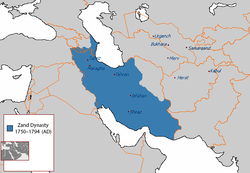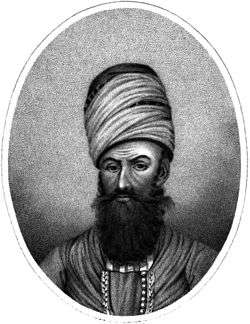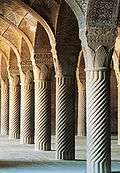Zand dynasty
| Zandiyeh dynasty | ||||||
| سلسله زندیه | ||||||
| ||||||
| ||||||
 | ||||||
| Capital | Shiraz | |||||
| Languages | Persian (official) | |||||
| Government | Monarchy | |||||
| Shah | ||||||
| • | 1750–1779 | Karim Khan Zand (first) | ||||
| • | 1789–1794 | Lotf Ali Khan Zand (last) | ||||
| History | ||||||
| • | Zandiyeh dynasty begins | 1750 | ||||
| • | Qajar dynasty begins | 1794 | ||||
| Today part of | | |||||
The Zandiyeh dynasty (Persian: سلسله زندیه, Silsilah-i Zandīyah; ![]() listen ) was an Iranian dynasty of Lurish or Kurdish origin founded by Karim Khan Zand that initially ruled southern and central Iran in the 18th century. It later quickly came to expand to include much of the rest of contemporary Iran, as well as Azerbaijan, and parts of Iraq and Armenia.
listen ) was an Iranian dynasty of Lurish or Kurdish origin founded by Karim Khan Zand that initially ruled southern and central Iran in the 18th century. It later quickly came to expand to include much of the rest of contemporary Iran, as well as Azerbaijan, and parts of Iraq and Armenia.
History
Karim Khan Zand

The dynasty was founded by Karim Khan, chief of the Zand tribe, which is a tribe of Laks,[1][2][3][4][5][6][7] or Lurs (according to David Yerushalmi)[8] or a branch of Kurds.[4][5][6][7] He became one of Nader Shah's generals.[9] Nader Shah moved the Zand tribe from their home in Lakestan to the eastern steppes of Khorasan. After Nader’s death, the Zand tribe, under the guidance of Karim Khan, went back to their original land.[10] After Adil Shah was made king Karim Khan and his soldiers defected from the army and along with Ali Morad Khan Bakhtiari and Abolfath Khan Haft Lang, two other local chiefs, became a major contender but was challenged by several adversaries.[11] Abolfath Khan was the Prime Minister, Karim Khan became the army chief commander and Ali Morad Khan became the regent.[11]
Karim Khan declared Shiraz his capital, and in 1778 Tehran became the second capital . He gained control of central and southern parts of Iran. In order to add legitimacy to his claim, Karim Khan placed the infant Shah Ismail III, the grandson of the last Safavid king, on the throne in 1757. Ismail was a figurehead king and real power was vested in Karim Khan. Karim Khan chose to be the military commander and Alimardan Khan was the civil administrator. Soon enough Karim Khan managed to eliminate his partner as well as the puppet king and in 1760, founded his own dynasty. He refused to accept the title of the king and instead named himself The Advocate of the People.
By 1760, Karim Khan had defeated all his rivals and controlled all of Iran except Khorasan, in the northeast, which was ruled by Shah Rukh. His foreign campaigns against Azad Khan in Azerbaijan and against the Ottomans in Mesopotamia brought Azerbaijan and the province of Basra into his control. But he never stopped his campaigns against his arch-enemy, Mohammad Hassan Khan Qajar, the chief of the Qoyunlu Qajars. The latter was finally defeated by Karim Khan and his sons, Agha Mohammad Khan and Hossein Quoli Khan, were brought to Shiraz as hostages.
Karim Khan's monuments in Shiraz include the famous Arg of Karim Khan, Vakil Bazaar, and several mosques and gardens. He is also responsible for building of a palace in the town of Tehran, the future capital of the Qajar dynasty.
Decline and fall
Karim Khan's death in 1779 left his territory vulnerable to threats from his enemies. His son and successor Abu al-Fath was an incompetent ruler who was heavily influenced by his half uncle (and Karim Khan's commander), Zaki Khan. Other rulers such as Ali Morad and Jafar Khan also failed to follow the policies of Karim Khan and soon enough, the country was under attack from all sides.
The biggest enemies of the Zands, the Qajar chiefs, led by the former hostage, Agha Mohammad Khan, were advancing fast against the declining kingdom. Finally, in 1789, Lotf Ali Khan, a grand-nephew of Karim Khan, declared himself the new king. His reign (until 1794) was spent mostly in war with the Qajar khan. He was finally captured and brutally killed in the fortress of Bam, putting an effective end to the Zand Dynasty.
Politically, it is also important that the Zands, especially Karim Khan, chose to call themselves Vakilol Ro'aya (Advocate of the People) instead of kings. Other than the obvious propaganda value of the title, it can be a reflection of the popular demands of the time, expecting rulers with popular leanings instead of absolute monarchs who were totally detached from the population, like the earlier Safavids.
After the Islamic Revolution of 1979 the Zand was the only dynasty whose names on public places and monuments were not removed by the new Republican government. Interestingly, a union was formed between the Zands and the Qajars in so far as Karim Khan's grand daughter, Bolour Khanum Zandieh married Mohammad Shah Qajar and bore him two daughters, Princess Ozra and Princess Effat ed-Dowleh.[12]
Culture
The Zand era was an era of relative peace and economic growth for the country. Many territories that were once captured by the Ottomans in the late Safavid era were retaken, and Iran was once again a coherent and prosperous country. After Iranian painting reached its height at the end of the 17th century, a special school of painting took shape during the Zand era in the 17th and 18th centuries.[13] The art of this era is remarkable and, despite the short length of the dynasty, a distinct Zand art had the time to emerge. Many Qajar artistic traits were copied from the Zand examples.
In foreign policy, Karim Khan attempted to revive the Safavid era trade by allowing the British to establish a trading post in the port of Bushehr. This opened the hands of the British East India company in Iran and increased their influence in the country.[14] The taxation system was reorganized in a way that taxes were levied fairly. The judicial system was fair and generally humane. Capital punishment was rarely implemented.[15]
Legacy

John R. Perry, writes of Karim Khan Zand as a forward-thinking and popular leader, whom he credits as opening up international trade, employing a fair fiscal system and showing respect for co-existing religious institutions.[16]
Rulers / kings of the Zand dynasty
- Karim Khan, 1750–1779 کریم خان زند
- Abol Fath Khan, 1779 ابولفتح خان زند
- Mohammad Ali Khan, 1779 محمدعلی خان زند
- Sadiq Khan, 1779–1782 صادق خان زند
- Ali Murad Khan, 1782–1785 علیمراد خان زند
- Jafar Khan, 1785–1789 جعفر خان زند
- Lotf Ali Khan, 1789–1794 لطفعلی خان زند
Other notable members
Family tree
Bodaq Khan | Agha Beygom I | Inaq Khan | |||||||||||||||||||||||||||||||||||||||||||||||||||||
| Allah Morad Khan | Agha Beygom II | Zaki Khan | Karim Khan 1750–1779 | Sadiq Khan 1779–1781 | |||||||||||||||||||||||||||||||||||||||||||||||||||
| Koda Morad Khan | Ali Murad Khan 1782–1785 | Akbar Khan | Abol Fath Khan 1779 | Mohammad Ali Khan 1779 | Jafa Khan 1785–1789 | ||||||||||||||||||||||||||||||||||||||||||||||||||
| Sayed Murad Khan 1789 | Rustam Khan | Lotf Ali Khan 1789–1794 | |||||||||||||||||||||||||||||||||||||||||||||||||||||
See also
References
- ↑ A fourth pretender was Karim Khan, son of Aymak of the Zand, a section of Lak tribe, Sir Percy Molesworth Sykes, A History of Persi, Macmillan and co., limited, 1930, p. 277.
- ↑ One of the contenders for power was Karim Khan Zand, a member of the Lak tribe near Shiraz, William Marsden, Stephen Album, Marsden's Numismata orientalia illustrata, Attic Books, 1977, ISBN 978-0-915018-16-1, p. 158.
- ↑ Karim Khan, the founder of the Zand dynasty of Persia that succeeded the Afsharids, was himself born to a family of these Lak deportees (of the Zand tribe), Mehrdad R. Izady, The Kurds: A Concise Handbook, Taylor & Francis, 1992, ISBN 978-0-8448-1727-9, p. 12.
- 1 2 Kurdish leader, Karim Khan Zand,..., Wadie Jwaideh, The Kurdish National Movement: Its Origins and Development, Syracuse University Press, 2006, ISBN 978-0-8156-3093-7, p. 17.
- 1 2 Lokman I. Meho, Kelly L. Maglaughlin, Kurdish Culture and Society: An Annotated Bibliography, Greenwood Publishing Group, 2001. ISBN 978-0-313-31543-5, p. 308.
- 1 2 ...the bulk of the evidence points to their being one of the northern Lur or Lak tribes, who may originally have been immigrants of Kurdish origin., Peter Avery, William Bayne Fisher, Gavin Hambly, Charles Melville (ed.), The Cambridge History of Iran: From Nadir Shah to the Islamic Republic, Cambridge University Press, 1991, ISBN 978-0-521-20095-0, p. 64.
- 1 2 Jwaideh, Wadie (2006). The Kurdish national movement: its origins and development.
- ↑ Muhammad Karim Khan, of the Zand clan of the Lur tribe, suc- ceeded in imposing his authority on parts of the defunct Safavid empire, David Yeroushalmi, The Jews of Iran in The Nineteenth Century: Aspects of History, Community, and Culture, BRILL, 2009, ISBN 978-90-04-15288-5, p. xxxix.
- ↑ History of Iran: Zand Dynasty
- ↑ http://www.iranologie.com/history/history13.html
- 1 2 History of Iran
- ↑ http://www.qajarpages.org/mohammadshahchildren.html
- ↑ New Page 1
- ↑ Iran & Iranian History – Afshar and Zand
- ↑ History of Iran – Kajar Dynasty – InfoHub
- ↑ Makers of the Muslim World Series -Karim Khan Zand, by John R. Perry, Oneworld Publications October 2006, ISBN 1-85168-435-2
External links
| Wikimedia Commons has media related to Zand dynasty. |
- www.iranchamber.com/history/zand/zand.php
- www.iranologie.com/history/history13.html
- www.friesian.com/iran.htm#zand
- www.zandbenevolent.com
| — Royal house — House of Zand Founding year: 1760 Deposition: 1794 | ||
| Preceded by Afsharid dynasty |
Ruling house of Iran 1760–1794 |
Succeeded by House of Qâjâr |
| ||||||||||||||||||||||||||||||||||||||||||||||||||||||||||||||||||||||||||||||||||||||||||||||||||||||||||||||||||||||||||||||||||||||||||||||||||||||||||
| ||||||||||||||||||||||


